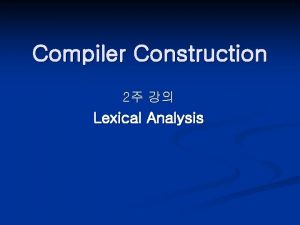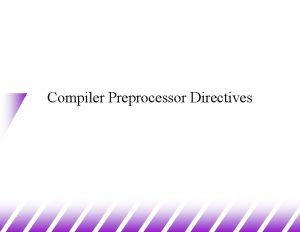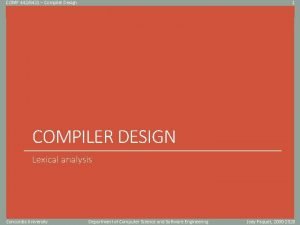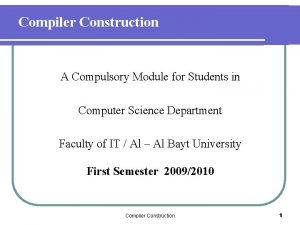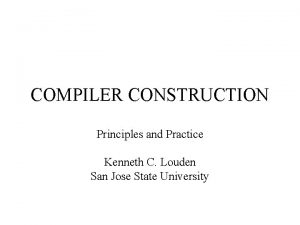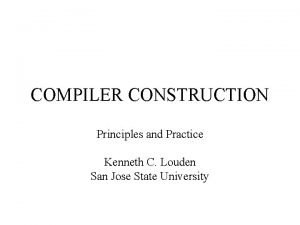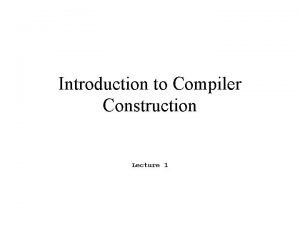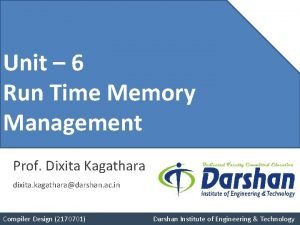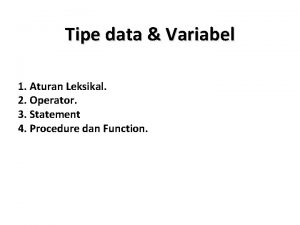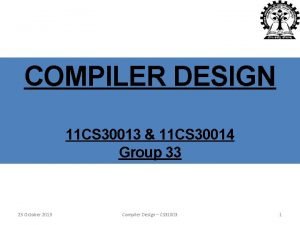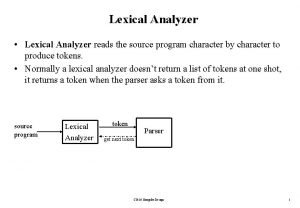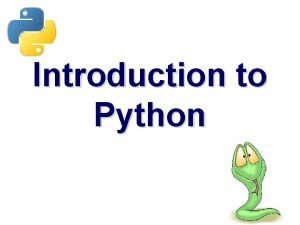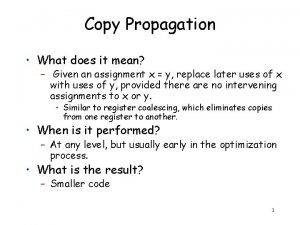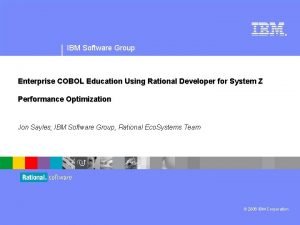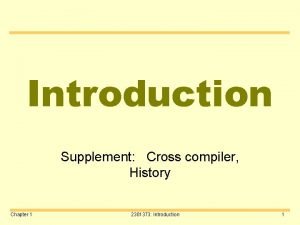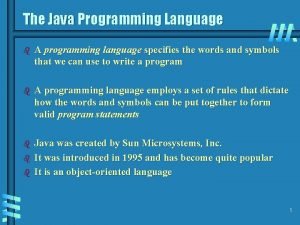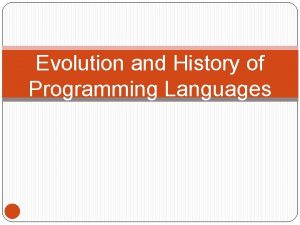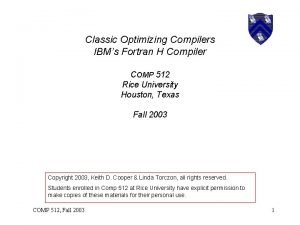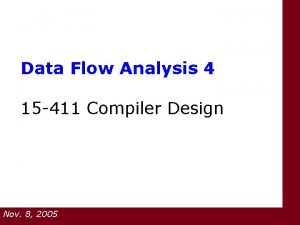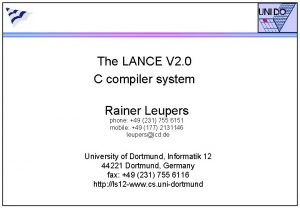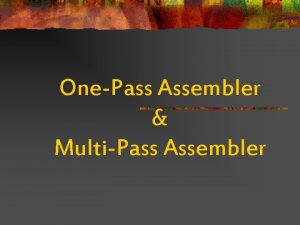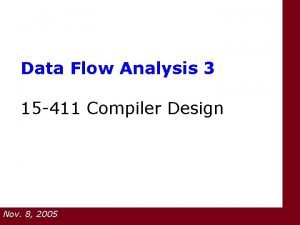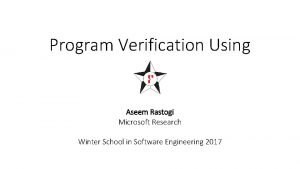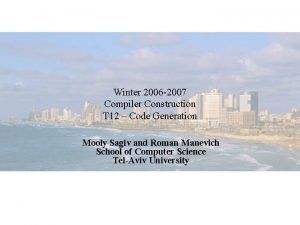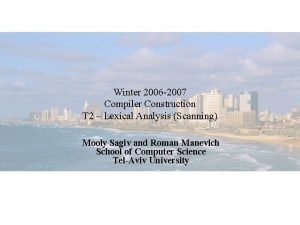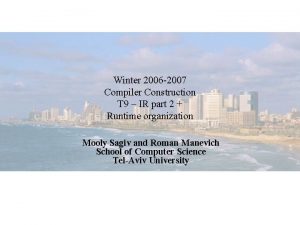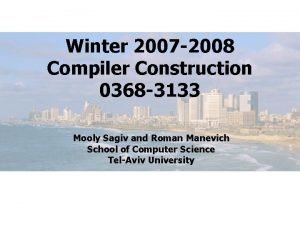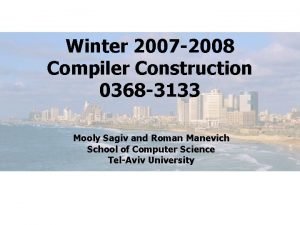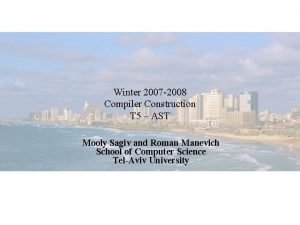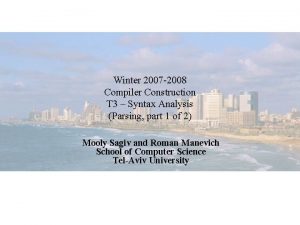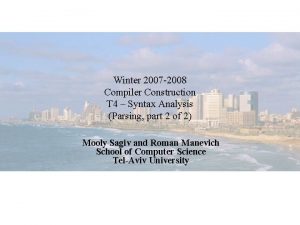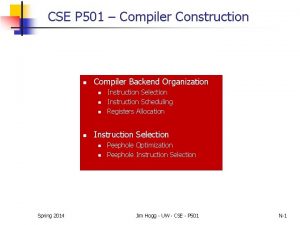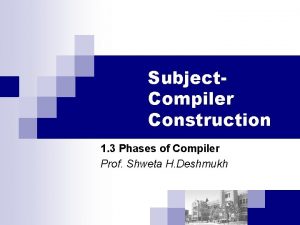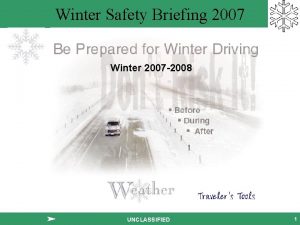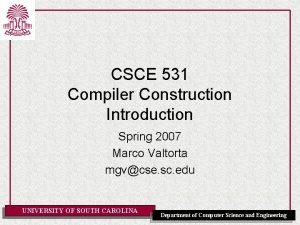Winter 2006 2007 Compiler Construction T 10 IR



![Translating call/return TR[C. foo(e 1, …, en)] R 1 : = TR[e 1] formal Translating call/return TR[C. foo(e 1, …, en)] R 1 : = TR[e 1] formal](https://slidetodoc.com/presentation_image/0d53aaa8e457e438551a3090c9e2efb4/image-4.jpg)

![LIR program (manual trans. ) str 1: “y=“ _DV_A: [_A_foo] _DV_B: [_B_foo] # Literal LIR program (manual trans. ) str 1: “y=“ _DV_A: [_A_foo] _DV_B: [_B_foo] # Literal](https://slidetodoc.com/presentation_image/0d53aaa8e457e438551a3090c9e2efb4/image-6.jpg)







![Accumulator registers TR[e 1 OP e 2] a+(b*c) Naïve translation R 1 : = Accumulator registers TR[e 1 OP e 2] a+(b*c) Naïve translation R 1 : =](https://slidetodoc.com/presentation_image/0d53aaa8e457e438551a3090c9e2efb4/image-14.jpg)
![Accumulator registers cont. n Accumulating instructions, use: n n Move. Array R 1[R 2], Accumulator registers cont. n Accumulating instructions, use: n n Move. Array R 1[R 2],](https://slidetodoc.com/presentation_image/0d53aaa8e457e438551a3090c9e2efb4/image-15.jpg)


![Example R 0 : = TR[((c*d)-(e*f))+(a*b)] c = 0 R 0 : = c*d Example R 0 : = TR[((c*d)-(e*f))+(a*b)] c = 0 R 0 : = c*d](https://slidetodoc.com/presentation_image/0d53aaa8e457e438551a3090c9e2efb4/image-18.jpg)

![Example R 0 : = TR[a+(b+(c*d))] left child first R 0 + R 0 Example R 0 : = TR[a+(b+(c*d))] left child first R 0 + R 0](https://slidetodoc.com/presentation_image/0d53aaa8e457e438551a3090c9e2efb4/image-20.jpg)













- Slides: 33

Winter 2006 -2007 Compiler Construction T 10 – IR part 3 + Activation records Mooly Sagiv and Roman Manevich School of Computer Science Tel-Aviv University

Today ic Lexical Analysis Syntax Analysis AST Parsing IC Symbol Table etc. Inter. Rep. (IR) Code Generation Language n Today: n LIR n n n Spec. + micro. LIR Strings and arrays PA 4 Optimizations exe Executable code n Next time: n n n Introduction to x 86 assembly Code generation Activation records in depth Runtime organization n Activation records 2

LIR language n Supports n n n Literal strings Dispatch tables Instruction set Unbounded number of registers Object/array allocation via library functions n n n Updating DVPtr with LIR instructions Missing from printout: Array. Length instruction Notice special syntax for parameter passing for static/virtual function calls No representation of activation records (frames) No calling sequence protocols n n Just Call/Return instructions this variable “magically” updated on call to virtual functions 3
![Translating callreturn TRC fooe 1 en R 1 TRe 1 formal Translating call/return TR[C. foo(e 1, …, en)] R 1 : = TR[e 1] formal](https://slidetodoc.com/presentation_image/0d53aaa8e457e438551a3090c9e2efb4/image-4.jpg)
Translating call/return TR[C. foo(e 1, …, en)] R 1 : = TR[e 1] formal parameter name … Rn : = TR[en] Static. Call C_foo(x 1=R 1, …, xn=Rn), R TR[e 1. foo(e 2)] R 1 : = TR[e 1] R 2 : = TR[e 2] actual argument register Virtual. Call R 1. cfoo(x=R 2), R TR[return e] R 1 : = TR[e] Return R 1 Constant representing offset of method f in dispatch table of class type of e 1 4

LIR translation example class A { int x; string s; int foo(int y) { int z=y+1; return z; } static void main(string[] args) { A p = new B(); p. foo(5); } Translating virtual function calls } Translating virtual functions (dispatch tables) Translating the main function class B extends A { Translation for literal strings int z; int foo(int y) { s = “y=“ + Library. itos(y); Library. println(s); int[] sarr = Library. stoa(s); int l = sarr. length; Translating. length Library. printi(l); operator return l; } } 5
![LIR program manual trans str 1 y DVA Afoo DVB Bfoo Literal LIR program (manual trans. ) str 1: “y=“ _DV_A: [_A_foo] _DV_B: [_B_foo] # Literal](https://slidetodoc.com/presentation_image/0d53aaa8e457e438551a3090c9e2efb4/image-6.jpg)
LIR program (manual trans. ) str 1: “y=“ _DV_A: [_A_foo] _DV_B: [_B_foo] # Literal string in program # dispatch table for class A # dispatch table for class B _A_foo: Move y, R 1 Add 1, R 1 Move R 1, z Return z # int foo(int y) # int z=y+1; _B_foo: Library __itos(y), R 1 Library __string. Cat(str 1, R 1), R 2 Move this, R 3 Move. Field R 2, R 3. 3 Move. Field R 3. 3, R 4 Library __println(R 4), Rdummy Library __stoa(R 4), R 5 Move R 5, sarr Array. Length sarr, R 6 Move R 6, l Library __printi(l), Rdummy Return l # # # main in A _ic_main: Library __allocate. Object(16), R 1 Move. Field _DV_B, R 1. 0 Virtual. Call R 1. 0(y=5), Rdummy # return z; int foo(int y) Library. itos(y); "y=" + Library. itos(y); this. s = "y=" + Library. itos(y); # int[] sarr = Library. stoa(s); # int l = sarr. length; # Library. printi(l) # return l; # # A {static void main(string[] args)…} A p = new B(); Update DVPtr of new object p. foo(5) 6

Class layout implementation class A { int x_1; . . . boolean x_n; void foo_1(…) {…}. . . int foo_n(…) {…} } 1: generate dispatch tables 2: determine method offsets in virtual calls 3: determine field offsets in field access statements class Class. Layout { Map<Method, Integer> method. To. Offset; // DVPtr = 0 Map<Field, Integer> field. To. Offset; } field. To. Offset x_1 = 1 … x_n = n method. To. Offset foo_1 = 0 … foo_n = n-1 file. lir 1 _DV_A: [foo_1, …, foo_n] 2 . . . Virtual. Call R 1. 7(), R 3 3 Move. Field R 1. 3, 9 7

micro. LIR simulator n Java application n Use it to test your translation n n n n Accepts file. lir (your translation) Executes program Checks correct syntax Performs lightweight semantic checks Runtime semantic checks Debug modes (-verbose: 1/2) Prints program statistics (#registers) Comes with sample inputs Read manual Comes with sources (allowed to use in PA 4) Not heavily tested (better than nothing) 8

PA 4 n Translate AST to LIR (file. ic -> file. lir) n n n Dispatch table for each class Literal strings (all literal strings in file. ic) Instruction list for every function n Label of main function should be _ic_main Maintain internally for each function n n List of LIR instructions Reference to method AST node n n Needed to generate frame information in PA 5 Maintain for each call instruction n Reference to method AST n n Leading label for each function _CLASS_FUNC Needed to generate call sequence in PA 5 Optimizations (WARNING: only after assignment works) n Keep optimized and non-optimized translations separately 9

Representing arrays/strings str 1: “Hello!” 6 72 101 108 111 33 __allocate. Array(12), R 1 # 3*4=12 bytes Array length R 1: [1, 2, 3] 3 1 2 3 1 word = 4 bytes 10

LIR optimizations n Aim to reduce number of LIR registers n n n Reduce size of activation records Allow better register allocation in PA 5 Also reduces number of instructions n Avoid storing variables and constants in registers Use accumulator registers Reuse “dead” registers Weighted register allocation n (More complicated: reuse assigned values in block) n Merge consecutive labels n n Left to PA 5 (generates additional labels) 11

Avoid storing constants and variables in registers n Naïve translation of AST leaves n n n For a constant TR[5] = Move 5, Rj For a variable TR[x] = Move x, Rk Better translation n For a constant TR[5] = 5 For a variable TR[x] = x What about TR[x+5]=? n n n WRONG: TR[x+5] = Add TR[x], TR[5] = Add x, 5 TR[x+5] = Move 5, R 1 Add x, R 1 Assign to register if both operands non-registers 12

Accumulator registers n n Use same register for sub-expression and result Very natural for 2 -address code and previous optimization TR[e 1 OP e 2] Naïve translation R 1 : = TR[e 1] R 2 : = TR[e 2] R 3 : = R 1 OP R 2 Better translation R 1 : = TR[e 1] R 2 : = TR[e 2] R 1 : = R 1 OP R 2 13
![Accumulator registers TRe 1 OP e 2 abc Naïve translation R 1 Accumulator registers TR[e 1 OP e 2] a+(b*c) Naïve translation R 1 : =](https://slidetodoc.com/presentation_image/0d53aaa8e457e438551a3090c9e2efb4/image-14.jpg)
Accumulator registers TR[e 1 OP e 2] a+(b*c) Naïve translation R 1 : = TR[e 1] R 2 : = TR[e 2] R 3 : = R 1 OP R 2 Move a, R 1 Move b, R 2 Mul R 1, R 2 Move R 2, R 3 Move c, R 4 Add R 3, R 4 Move R 4, R 5 Better translation R 1 : = TR[e 1] R 2 : = TR[e 2] R 1 : = R 1 OP R 2 Move b, R 1 Mul c, R 1 Add a, R 1 14
![Accumulator registers cont n Accumulating instructions use n n Move Array R 1R 2 Accumulator registers cont. n Accumulating instructions, use: n n Move. Array R 1[R 2],](https://slidetodoc.com/presentation_image/0d53aaa8e457e438551a3090c9e2efb4/image-15.jpg)
Accumulator registers cont. n Accumulating instructions, use: n n Move. Array R 1[R 2], R 1 Move. Field R 1. 7, R 1 Static. Call _foo(R 1, …), R 1 … 15

Reuse registers n Registers have very-limited lifetime n n Currently stored values used exactly once (All LIR registers become dead after statement) Suppose TR[e 1 OP e 2] translated as R 1: =TR[e 1], R 2: =TR[e 2], R 1: =R 1 OP R 2 Registers from TR[e 1] can be reused in TR[e 2] Algorithm: n n n Use a stack of temporaries (LIR registers) Stack corresponds to recursive invocations of t : = TR[e] All the temporaries on the stack are alive 16

Reuse registers cont. n Implementation: use counter c to implement live register stack n n Registers R(0)…R(c) are alive Registers R(c+1), R(c+2)… can be reused Push means increment c, pop means decrement c In the translation of R(c)=TR[e 1 OP e 2] R(c) : = TR[e 1] c = c + 1 R(c) : = TR[e 2] c = c - 1 R(c) : = R(c) OP R(c+1) 17
![Example R 0 TRcdefab c 0 R 0 cd Example R 0 : = TR[((c*d)-(e*f))+(a*b)] c = 0 R 0 : = c*d](https://slidetodoc.com/presentation_image/0d53aaa8e457e438551a3090c9e2efb4/image-18.jpg)
Example R 0 : = TR[((c*d)-(e*f))+(a*b)] c = 0 R 0 : = c*d c = c + 1 R 0 : = TR[(c*d)-(e*f)] R 1 : = e*f c = c - 1 R 0 : = R 0 -R 1 c = c + 1 R 1 : = a*b c = c - 1 R 0 : = R 0 + R 1 18

Weighted register allocation n Suppose we have expression e 1 OP e 2 n n n e 1, e 2 without side-effects (function calls, assignments) OP is commutative: *, + TR[e 1 OP e 2] = TR[e 2 OP e 1] Does order matter? Use the Sethi & Ullman algorithm n Weighted register allocation – translate heavier sub-tree first 19
![Example R 0 TRabcd left child first R 0 R 0 Example R 0 : = TR[a+(b+(c*d))] left child first R 0 + R 0](https://slidetodoc.com/presentation_image/0d53aaa8e457e438551a3090c9e2efb4/image-20.jpg)
Example R 0 : = TR[a+(b+(c*d))] left child first R 0 + R 0 a R 1 right child first R 0 a + b R 2 + b * c Translation uses all optimizations shown until now uses 3 registers R 0 d + R 0 * c R 0 d Managed to save two registers register 20

Weighted register allocation n n Can save registers by re-ordering (commutative) subtree computations Label each node with its weight n n n Weight = number of registers needed Leaf weight known Internal node weight n n n w(left) > w(right) then w = left w(right) > w(left) then w = right w(right) = w(left) then w = left + 1 Choose heavier child as first to be translated WARNING: have to check that no side-effects exist before attempting to apply this optimization (pre-pass on the tree) 21

LIR vs. assembly #Registers Function calls Instruction set Types LIR Unlimited Implicit Abstract Basic and user defined Assembly Limited Runtime stack Concrete Limited basic types Actually very limited in our LIR 22

Function calls n n LIR – simply call/return Conceptually n n n Supply new environment (frame) with temporary memory for local variables Pass parameters to new environment Transfer flow of control (call/return) Return information from new environment (ret. value) Assembly – pass parameters (+this), save registers, call, restore registers, return, pass return value, virtual method lookup 23

Activation records n n New environment = activation record (a. k. a. frame) Activation record = data of current function / method call n User data n n n Administration data n n n Local variables Parameters Return values Register contents Code addresses Pointers to other activation records (not in IC) In IC – a stack is sufficient ! 24

Runtime stack n n n Stack of activation records Call = push new activation record Return = pop activation record Only one “active” activation record – top of stack This is enough to handle recursion 25

Runtime stack n n Sometimes called BP (base pointer) … n Stack grows downwards (towards smaller addresses) SP – stack pointer – top of current frame FP – frame pointer – base of current frame … n Previous frame FP Current frame SP 26

Pentium runtime stack Register Usage Instruction Usage ESP Stack pointer push, pusha, … Push on runtime stack EBP Base pointer pop, popa, … Pop from runtime stack call Transfer control to called routine ret Transfer control back to caller Pentium stack registers Pentium stack and call/ret instructions 27

Call sequences n n The processor does not save the content of registers on procedure calls So who will? n n n Caller saves and restores registers Callee saves and restores registers But can also have both save/restore some registers 28

caller Call sequences Caller push code callee Callee push code (prologue) Callee pop code (epilogue) caller return Caller pop code Push caller-save registers Push actual parameters (in reverse order) push return address Jump to call address Push current base-pointer bp = sp Push local variables Push callee-save registers Pop callee activation record Pop old base-pointer pop return address Jump to address Pop parameters Pop caller-save registers 29

caller Call sequences – Foo(42, 21) push %ecx push $21 push $42 call _foo Push caller-save registers Push actual parameters (in reverse order) push return address Jump to call address call push %ebp callee mov %esp, %ebp sub %8, %esp Push current base-pointer bp = sp Push local variables (callee variables) Push callee-save registers push %ebx pop %ebx mov %ebp, %esp pop %ebp Pop callee-save registers Pop callee activation record Pop old base-pointer ret caller return add $8, %esp pop return address Jump to address pop %ecx Pop parameters Pop caller-save registers 30

“To Callee-save or to Caller-save? ” n n Callee-saved registers need only be saved when callee modifies their value Some conventions exist (cdecl) n n n %eax, %ecx, %edx – caller save %ebx, %esi, %edi – callee save %esp – stack pointer %ebp – frame pointer Use %eax for return value 31

Accessing stack variables n n n FP+8 … n Use offset from EBP Remember – stack grows downwards Above EBP = parameters Below EBP = locals Examples … n param n … param 1 Return address FP FP-4 %ebp + 4 = return address %ebp + 8 = first parameter %ebp – 4 = first local Previous fp Local 1 … Local n param n … param 1 SP Return address 32

Happy new year! 33
 Yacc tutorial
Yacc tutorial Cross compiler in compiler design
Cross compiler in compiler design Winter kommt winter kommt flocken fallen nieder
Winter kommt winter kommt flocken fallen nieder Winter kommt flocken fallen nieder
Winter kommt flocken fallen nieder Meine lieblingsjahreszeit ist der winter
Meine lieblingsjahreszeit ist der winter Backend of compiler
Backend of compiler Lexical analysis
Lexical analysis Type checking in compiler construction
Type checking in compiler construction Preprocessor in compiler construction
Preprocessor in compiler construction Thompson construction in compiler design
Thompson construction in compiler design Machine independent code optimization
Machine independent code optimization Introduction to compiler and interpreter
Introduction to compiler and interpreter Explain compiler construction tools
Explain compiler construction tools Compiler
Compiler Kenneth c. louden
Kenneth c. louden If the lexical analyzer finds a token invalid then?
If the lexical analyzer finds a token invalid then? Sub division of run time memory
Sub division of run time memory Operator matematika
Operator matematika Language processor mcq
Language processor mcq Applications of sdd in compiler design
Applications of sdd in compiler design Sementic
Sementic Followpos in compiler design
Followpos in compiler design Python history and features
Python history and features Copy propagation in compiler design
Copy propagation in compiler design Ssrange in cobol example
Ssrange in cobol example Cousins of compiler
Cousins of compiler Java interpreter
Java interpreter 3rd generation programming language
3rd generation programming language The fortran optimizing compiler
The fortran optimizing compiler Constant propagation in compiler design
Constant propagation in compiler design Lance compiler
Lance compiler Explain multi pass assembler in detail
Explain multi pass assembler in detail Global data flow analysis in compiler design
Global data flow analysis in compiler design C compiler
C compiler






